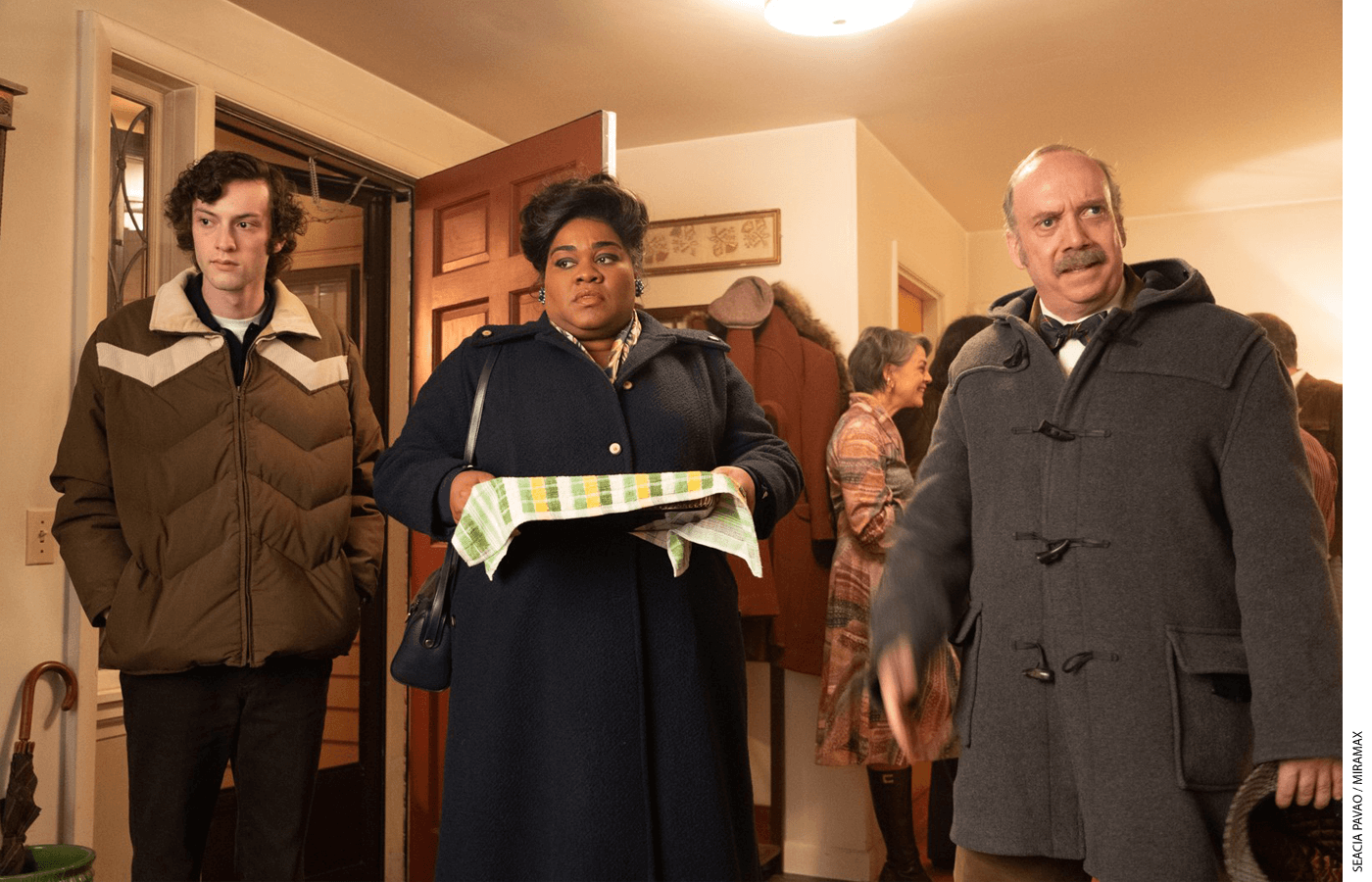
The Holdovers
Directed by Alexander Payne
Miramax 2023, 133 minutes
As reviewed by Chester E. Finn Jr.
Warning: This review contains plot details from the movie.
In this superb but “of-its-period” movie, Paul Giamatti deserved an Oscar for Best Actor based on facial expressions alone. Not that his visage is all that rubbery, but in his role as Mr. Hunham, a boarding-school teacher of classical civilizations circa 1970, he deploys it to marvelous effect to convey moods, anxieties, affection, rejection, superiority, inferiority and so much more.
Giamatti’s memorable performance, which indeed earned him an Oscar nomination (ultimately lost to Cillian Murphy for Oppenheimer), is one of three in this beautifully wrought depiction of life in a classic New England boys’ boarding school in the era of Vietnam, shaggy hair, marijuana, and other rebellions against traditional authority.
It does not, however, depict regular campus life. As you have doubtless read in other reviews—and in keeping with the film’s release just in time for Christmas—the “holdovers” are a handful of students and adults who get stuck at the fictional Barton Academy when everyone else takes off for winter break. Five kids are housed in the infirmary—the financially stressed school shuts down the heat elsewhere—where they are overseen by the grumpy, irascible Hunham, who gets stuck with holiday duty as punishment for flunking the son of a rich, influential alum. This sorry band is fed by Mary, played by the awesome Da’Vine Joy Randolph (who deservedly won Best Supporting Actress for the role), the school’s Black kitchen chief, whose own son—himself a Barton graduate—has recently been killed in Vietnam.
Twenty minutes into the film, four of the kids get rescued by a plutocratic parent who descends via helicopter to spirit them off on a ski holiday, but Tully, played by the youthful but gifted Dominic Sessa, remains behind, now alone for the duration with Mary and Mr. Hunham.
Each has their secrets, each their sorrows and failings, and singular challenges abound. Yet the three come together in ways that unexpectedly turn out to be mutually supportive and, by the end, each character has become admirable as well as affecting.
Watch it, by all means. (Before letting kids watch it with you, though, be aware that there’s much cussing.) As for a window into prep schools, however, watch it as a sort of time capsule, skillfully evoking a period half a century ago when those campuses differed greatly from what you find today.
Back then, almost all prep schools were single-sex, and most were full of rich, white, American kids from middle (and upper) class families. The dress code was enforced. The curriculum was traditional. Instruction was mostly sage-on-stage. Discipline could be harsh. Sports were serious, but feelings were ignored. The dining hall offered few choices—and the food was blah—but you could smoke in the dorm’s “butt room.”
These schools feel very different today. Those that I know are all coed, and their students are diverse in all the ways you can think of, including many from other countries. Full-pay tuition is sky-high, but as many as half the kids get scholarships. The dress code—if there is one—is quite casual. Vegan options abound. The curriculum includes lots of STEM, arts, and hot topics such as environment, race, and gender. Classrooms are participatory. Extracurricular activities are all over the place. So are the kids, pursuing bountiful opportunities for studying abroad, “semester in Washington,” that sort of thing. Discipline allows second, third, and maybe fourth chances. And there’s lots and lots and lots of attention paid to students’ well-being—to social, emotional and physical health. Instead of sink-or-swim, pass-your-courses-or-go-home, these campuses have become kinder, gentler places that bend over backwards to help kids cope.
I’m an old-fashioned hardline sort who tends to think that today’s prep schools have grown soft and—like the elite colleges they mostly feed into—have gone way too deep into DEI, affirming everything, and worrying overmuch about feelings. But I have to admit that when someone I’m close to enrolled in my alma mater thirty years later and found herself struggling academically, I was mighty glad the school mustered tutors and advisors to ensure her success. Back in my day, she likely would have been expelled. (She ended up graduating with honors.)
Tully, too, is headed for expulsion from Barton Academy. In the end, however, Mr. Hunham comes to the rescue—at considerable cost to himself. Though the movie is a period piece, today’s audiences, especially at Christmastime, expect to find signs of humanity along with fine acting. The Holdovers delivers plenty of both.
Chester E. Finn Jr. is a Distinguished Senior Fellow and President Emeritus at the Thomas B. Fordham Institute. He is also a Senior Fellow at Stanford’s Hoover Institution.
Note: This post was updated to reflect the outcomes of the Academy Awards on March 10, 2024.
This article appeared in the Summer 2024 issue of Education Next. Suggested citation format:
Finn, C.E. (2024). Prep-School Nostalgia Evoked in The Holdovers: The Oscar-nominated film delivers a blast from the past—and a reminder of how things have changed. Education Next, 24(3), 78-79.


